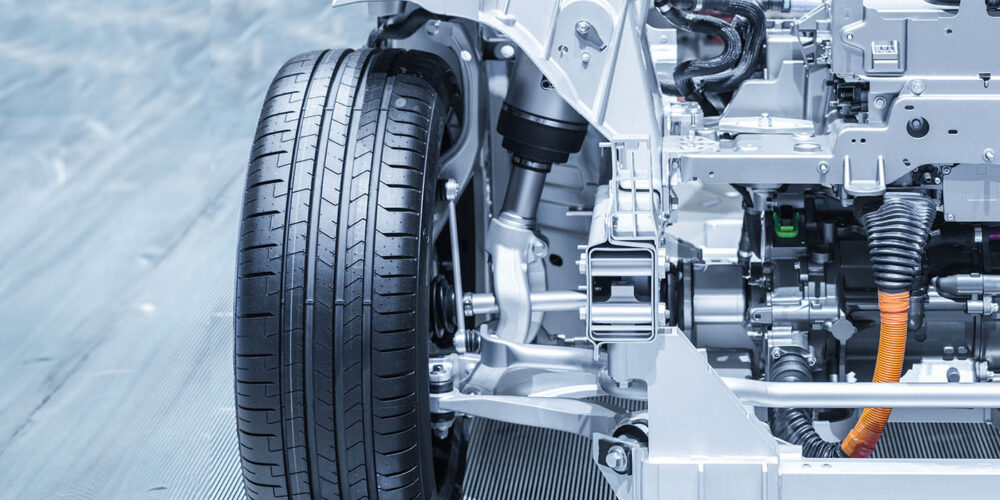A Firestone sales jingle gave us a good definition of chassis dynamics: “Where the rubber meets the road.” There are four tire tread contact patches that support the weight and control the motion of a vehicle. There are a lot of terms used to describe the motion of an automotive chassis and how it affects “where the rubber meets the road.”
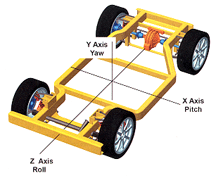 Starting with sway – the motion of a car rocking from side to side as it rounds a corner. The term “dive” refers to when a driver slams on the brakes and the nose of the car dives toward the road. “Squat” is when on acceleration, the nose comes up and rear the suspension drops. An extreme squat is called a “wheelie.” Oversteer is a when you go into a turn and rear wheels lose traction and the car spins out. Understeer is when the steering wheel is turned, but the car doesn’t turn.
Starting with sway – the motion of a car rocking from side to side as it rounds a corner. The term “dive” refers to when a driver slams on the brakes and the nose of the car dives toward the road. “Squat” is when on acceleration, the nose comes up and rear the suspension drops. An extreme squat is called a “wheelie.” Oversteer is a when you go into a turn and rear wheels lose traction and the car spins out. Understeer is when the steering wheel is turned, but the car doesn’t turn.
Today, aviation terminology used to describe how an aircraft moves through the air is being used for how the rubber reacts to steering, braking and acceleration. The terms are roll (replaces sway); pitch (replaces dive and squat); and yaw (replaces oversteer). Yaw can also describe as sideslip.
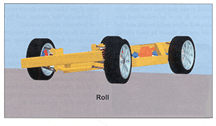 The chassis is on a set of axis that corresponds to the axis used for graphing. Facing the front of the vehicle, the Z roll axis is a line that passes through the roll center of the front suspension and rear suspension. This line or axis moves with the change in position of the front and rear suspension when the vehicle is cornering, accelerating and braking. The X pitch axis is a line or axis that passes through the center of gravity of the vehicle. A vehicle will move on this axis under acceleration and braking. The Y (Yaw) axis is at the center of gravity and roll axis. The angle generated by the force of the vehicle rounding a corner is called sideslip.
The chassis is on a set of axis that corresponds to the axis used for graphing. Facing the front of the vehicle, the Z roll axis is a line that passes through the roll center of the front suspension and rear suspension. This line or axis moves with the change in position of the front and rear suspension when the vehicle is cornering, accelerating and braking. The X pitch axis is a line or axis that passes through the center of gravity of the vehicle. A vehicle will move on this axis under acceleration and braking. The Y (Yaw) axis is at the center of gravity and roll axis. The angle generated by the force of the vehicle rounding a corner is called sideslip.
Cornering or lateral acceleration causes the chassis to roll. The faster the vehicle speed in the corner, the more the chassis will tend to roll. Let’s look at roll where the rubber meets the road.
When the rubber meets the road, the most weight is placed on the outside front wheel. The weight on the inside front wheel is reduced. The weight on the outside rear wheel is also reduced. If the vehicle is breaking in the corner, more weight is shifted the outside front wheel. The inside rear wheel applies the least amount of weight to the road.
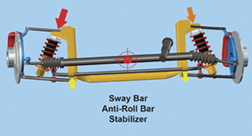 The sway bar, anti-roll bar or stabilizer, which ever you choose to call it, is a mechanical device that controls the amount of chassis roll. It is attached to the chassis and lower control arms of the suspension. The change in position of the control arms will cause the bar to lift the chassis on one side and pull the chassis on the other depending on the direction of the turn.
The sway bar, anti-roll bar or stabilizer, which ever you choose to call it, is a mechanical device that controls the amount of chassis roll. It is attached to the chassis and lower control arms of the suspension. The change in position of the control arms will cause the bar to lift the chassis on one side and pull the chassis on the other depending on the direction of the turn.
Acceleration and braking cause the vehicle to pitch, and the location of the center of gravity will change the amount of the dive or squat. The location of the center of gravity will change the amount of pitch. The vehicle will react more when the center is located higher in the vehicle.
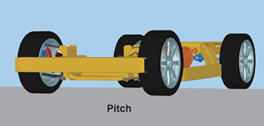 When the weight is transferred to the front wheels under braking, the rear wheels have a tendency to lock up. Proportioning valves and ABS can control these actions. Wheelbase also affects the amount of pitch. Under acceleration the chassis will pitch up and transfer the weight to the rear wheels. The grip of the rear tires can cause the front wheels to lift off the road. In the case of a front wheel drive vehicle, acceleration can cause a loss of grip. The longer the wheelbase and the lower the center of gravity, the less pitch of the chassis.
When the weight is transferred to the front wheels under braking, the rear wheels have a tendency to lock up. Proportioning valves and ABS can control these actions. Wheelbase also affects the amount of pitch. Under acceleration the chassis will pitch up and transfer the weight to the rear wheels. The grip of the rear tires can cause the front wheels to lift off the road. In the case of a front wheel drive vehicle, acceleration can cause a loss of grip. The longer the wheelbase and the lower the center of gravity, the less pitch of the chassis.
Yaw, also known as sideslip, is a lateral force caused by turning as a vehicle goes through a corner. Sideslip is affected by both roll and pitch. As the center of gravity moves forward, back and side-to-side, the sideslip angle can become greater or smaller. The greatest sideslip can occur while braking in a corner.
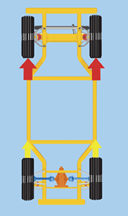 Roll is causing the weight to shift to the outside front wheel, and braking transferring weight to the front wheels. This results in little or no weight on the rear tire contact patches and increases the slip angle to a point where the vehicle loses control and spins. Today, computer-controlled ABS and throttle provide electronic stability control by modulating the throttle and applying braking to a individual wheel to provide sideslip control.
Roll is causing the weight to shift to the outside front wheel, and braking transferring weight to the front wheels. This results in little or no weight on the rear tire contact patches and increases the slip angle to a point where the vehicle loses control and spins. Today, computer-controlled ABS and throttle provide electronic stability control by modulating the throttle and applying braking to a individual wheel to provide sideslip control.
Neutral steer, understeer and oversteer are terms used to describe the chassis reaction to steering wheel input. Neutral steer is when the vehicle tracks through a corner on the turning circle generated by the front wheels. Understeer is when the vehicle tracks through a corner on a turning circle greater than the one generated by the front wheels. Oversteer is when the vehicle tracks through a corner on a turning circle that is less than the one generated by the front wheels.
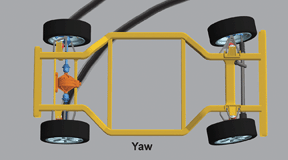 A great deal of time, energy and money are spent engineering a chassis that exhibit the best performance under all conditions, plus provide a ride that is acceptable to the driver. Tire size is very critical to the performance of the chassis. Remember, this is where the rubber meets the road. Changing tire diameter and aspect ratio can have a significant affect on handling characteristics. How a vehicle is loaded can also affect the handling. 250 pounds of luggage in a roof rack can effectively change cornering and stopping ability. The overall conditions of the suspension components are also important. Ball joints and brakes don’t last.
A great deal of time, energy and money are spent engineering a chassis that exhibit the best performance under all conditions, plus provide a ride that is acceptable to the driver. Tire size is very critical to the performance of the chassis. Remember, this is where the rubber meets the road. Changing tire diameter and aspect ratio can have a significant affect on handling characteristics. How a vehicle is loaded can also affect the handling. 250 pounds of luggage in a roof rack can effectively change cornering and stopping ability. The overall conditions of the suspension components are also important. Ball joints and brakes don’t last.





